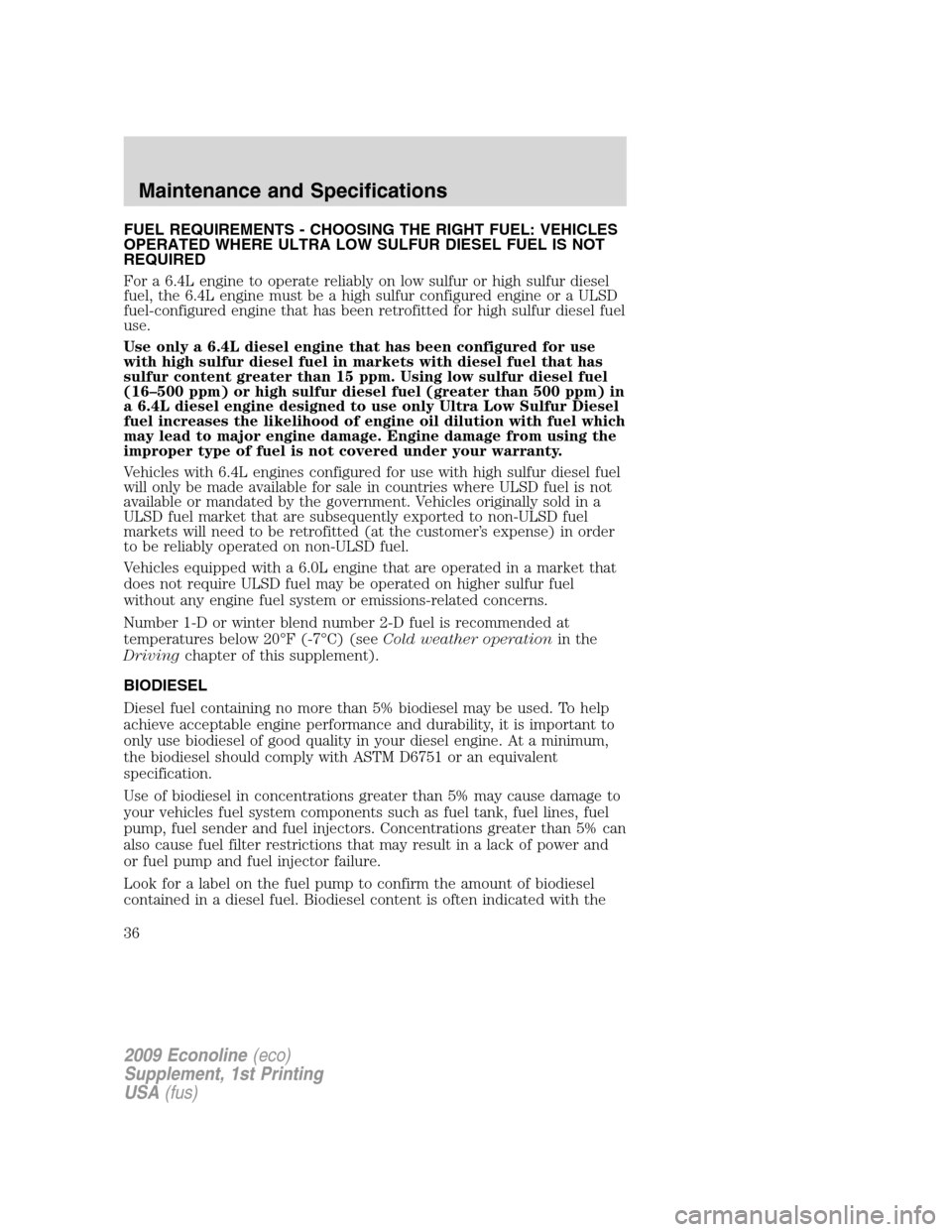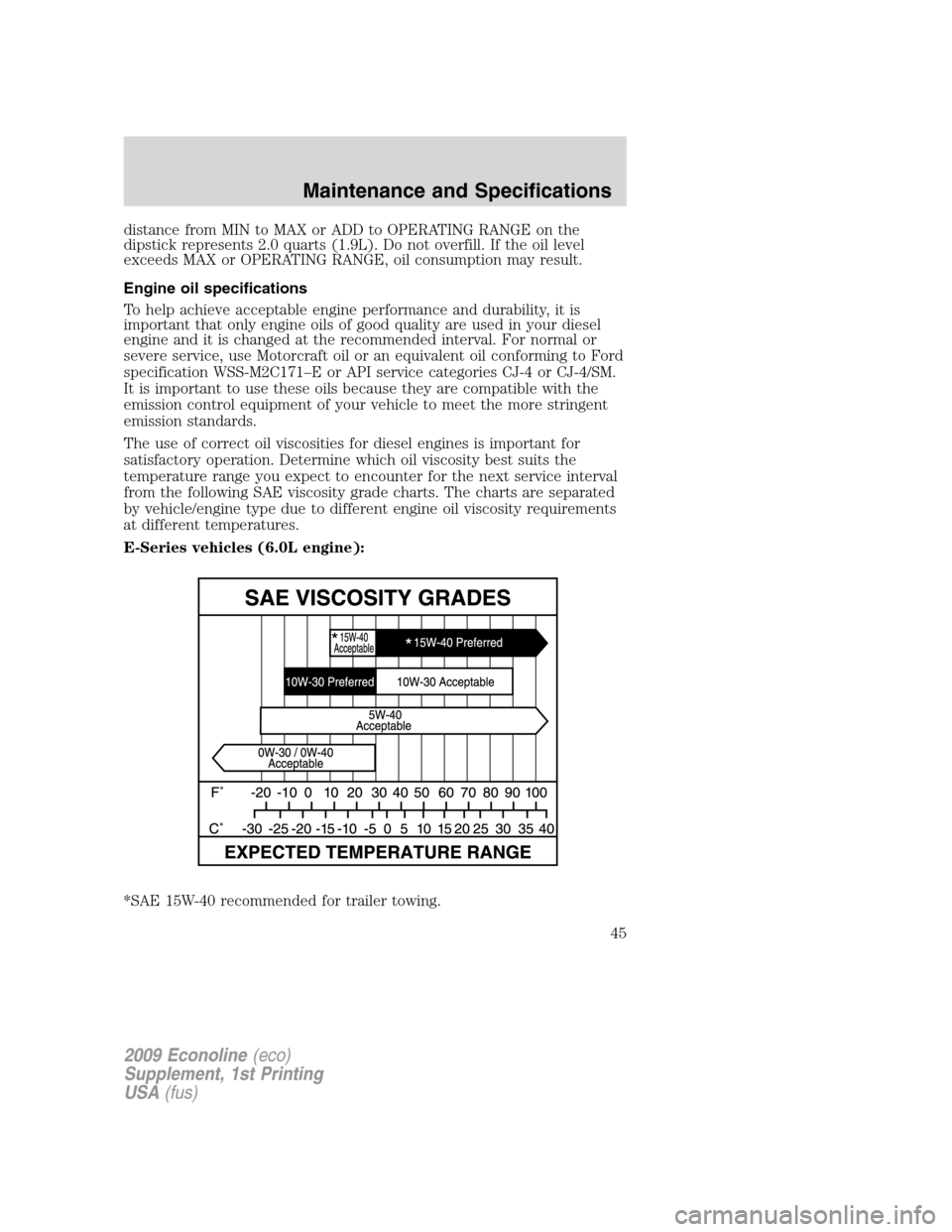oil type FORD SUPER DUTY 2009 2.G Diesel Supplement Manual
[x] Cancel search | Manufacturer: FORD, Model Year: 2009, Model line: SUPER DUTY, Model: FORD SUPER DUTY 2009 2.GPages: 103, PDF Size: 0.75 MB
Page 36 of 103

FUEL REQUIREMENTS - CHOOSING THE RIGHT FUEL: VEHICLES
OPERATED WHERE ULTRA LOW SULFUR DIESEL FUEL IS NOT
REQUIRED
For a 6.4L engine to operate reliably on low sulfur or high sulfur diesel
fuel, the 6.4L engine must be a high sulfur configured engine or a ULSD
fuel-configured engine that has been retrofitted for high sulfur diesel fuel
use.
Use only a 6.4L diesel engine that has been configured for use
with high sulfur diesel fuel in markets with diesel fuel that has
sulfur content greater than 15 ppm. Using low sulfur diesel fuel
(16–500 ppm) or high sulfur diesel fuel (greater than 500 ppm) in
a 6.4L diesel engine designed to use only Ultra Low Sulfur Diesel
fuel increases the likelihood of engine oil dilution with fuel which
may lead to major engine damage. Engine damage from using the
improper type of fuel is not covered under your warranty.
Vehicles with 6.4L engines configured for use with high sulfur diesel fuel
will only be made available for sale in countries where ULSD fuel is not
available or mandated by the government. Vehicles originally sold in a
ULSD fuel market that are subsequently exported to non-ULSD fuel
markets will need to be retrofitted (at the customer’s expense) in order
to be reliably operated on non-ULSD fuel.
Vehicles equipped with a 6.0L engine that are operated in a market that
does not require ULSD fuel may be operated on higher sulfur fuel
without any engine fuel system or emissions-related concerns.
Number 1-D or winter blend number 2-D fuel is recommended at
temperatures below 20°F (-7°C) (seeCold weather operationin the
Drivingchapter of this supplement).
BIODIESEL
Diesel fuel containing no more than 5% biodiesel may be used. To help
achieve acceptable engine performance and durability, it is important to
only use biodiesel of good quality in your diesel engine. At a minimum,
the biodiesel should comply with ASTM D6751 or an equivalent
specification.
Use of biodiesel in concentrations greater than 5% may cause damage to
your vehicles fuel system components such as fuel tank, fuel lines, fuel
pump, fuel sender and fuel injectors. Concentrations greater than 5% can
also cause fuel filter restrictions that may result in a lack of power and
or fuel pump and fuel injector failure.
Look for a label on the fuel pump to confirm the amount of biodiesel
contained in a diesel fuel. Biodiesel content is often indicated with the
2009 Econoline(eco)
Supplement, 1st Printing
USA(fus)
Maintenance and Specifications
36
Page 45 of 103

distance from MIN to MAX or ADD to OPERATING RANGE on the
dipstick represents 2.0 quarts (1.9L). Do not overfill. If the oil level
exceeds MAX or OPERATING RANGE, oil consumption may result.
Engine oil specifications
To help achieve acceptable engine performance and durability, it is
important that only engine oils of good quality are used in your diesel
engine and it is changed at the recommended interval. For normal or
severe service, use Motorcraft oil or an equivalent oil conforming to Ford
specification WSS-M2C171–E or API service categories CJ-4 or CJ-4/SM.
It is important to use these oils because they are compatible with the
emission control equipment of your vehicle to meet the more stringent
emission standards.
The use of correct oil viscosities for diesel engines is important for
satisfactory operation. Determine which oil viscosity best suits the
temperature range you expect to encounter for the next service interval
from the following SAE viscosity grade charts. The charts are separated
by vehicle/engine type due to different engine oil viscosity requirements
at different temperatures.
E-Series vehicles (6.0L engine):
*SAE 15W-40 recommended for trailer towing.
2009 Econoline(eco)
Supplement, 1st Printing
USA(fus)
Maintenance and Specifications
45